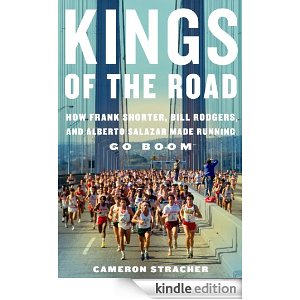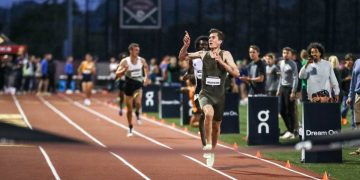It is very diificult for an author to write objectively about a subject in which they were a participant in those series of events. Cameron Stracher, who has competed in running on a high level for more than 30 years, was without a doubt one of those people who was a passing witness to the birth of the 1970’s running “boom” in America, as well as the personalities and events which affected and influenced the sport for a little more than ten years. Yet, as suddenly as the “boom” began, it came to an abrupt end, sometime between 1982 (the authors’ opinion) and 1984 (my humble opinion).
Regardless of the debate over it’s demise, Stracher has brilliantly woven a concise story of this period, interweaving it with the key people, personalities, and events in his book Kings of the Road . While the overview of the era deals with Frank Shorter, Bill Rodgers and Alberto Salazar, Stracher also proceeds to show the two men who guided the running “boom” to their liking; Tommy Leonard and Fred Lebow. The amazing interconnecting point of these five individuals is shown by the author to be the Falmouth Road Race in Cape Cod.
The book is not only a homage to these various people and events, but also a look at the subsequent positives and negatives created by all of these participants during this unpredictable maelstrom. Many in this era might consider the time to be like one big carpet ride, where runners came to a race to compete, and race directors, who often acted like circus ringmasters, tried to get as much out of them as possible. The race directors were there for many reasons: both to draw more runners, create an event for the masses, and make some money as well.
The book’s tempo might be described as ingredients being put together into a great recipe. The rise of Shorter, who many credit to have started the “boom” with his 1972 Olympic Marathon Gold, shows an athlete, who, in his developing years, and with no earnings at all in the sport, wanted to see how much he could get out of himself in running. All the while, Shorter had been keeping a facade which rarely displyed his true emotions, which, as the author writes, was developed during his diificult chioldhood.
Bill Rodgers, after competing at the High School and College level, and after drifiting around for a few years wearing a leather jacket and smoking two packs of cigarettes a day, also got back into running around 1973 for similar reasons.
Alberto Salazar, dubbed “The Rookie”, was the younger upstart of the three, who trained with Rodgers, and, with an amazing ability to withstand pain, would lead the “boom” towards it end, but not before almost dying in the 1978 Falmouth race.
Which brings us to the shared point of reference for Shorter, Rodgers and Salazar. Tommy Leonard, the man credited with creating the Falmouth race, was, according to Stracher, a man who “…ran for the beer.”
Leonard also said,”…a road race is a moving street party..At the end of every race, there’s a cold beer waiting.” Like many Americans watching the Olympics, he saw Shorter’s Gold Medal performance in Munich and was inspired to put on a run, hopefully luring Shorter himself to participate.
According to Stracher, Leonard, along with the input and help of Tom Carroll and Rich Sherman, created the Falmouth race in 1973. Ironically, none of the three stars mentioned above participated in the first event. The race was also set up to start and finish at two bars, so the 7.01 odd mile course with rolling hills and a tough one just before the 7 mile mark became a good testing ground for runners from milers up to marathoners.
From 1974 through 1982, the three “Kings of the Roads” were either competing or became a part of this “street party.” Bill Rodgers earliest key win was the 1974 Falmouth, where he beat top world miler Marty Liquori (you’ll have to read for yourself to find out the “prizes” Bill recieved), and through the showmanship and prodding of Leonard, led to Shorters’ arrival the next year. Shorter’s participation eventually inspired in his own way, the participation of a young Alberto Salazar, whose greatness would mature through each successive Falmouth run.
Aside from the play-by-play of each of the races, Stracher also gives great little tidbits on the early history of the sport, the world-class and Olympic performances of the runners who proceeded the “Kings” (Nurmi and Bannister, for instance), as well as explaining types of training and pacing involved in the athletes at that level.
Events such as the Munich terrorist incident and the 1980 Olympic boycott are covered as well. Stracher also writes about each of the “Kings” development.
Whether one is reading about Shorter’s tortuous childhood, or Rodgers’ ADHD (which has never been wriiten about before), or Salazar’s life in his passionate anti-Fidel Castro family household, the reader is definitley compelled to root for each one as their races transpire, whether they know the outcome or not. Stracher also includes their highlights in other races, notably the Boston and New York marathons, as well as writing about their contemporaries, notably Craig Virgin, Rod Dixon and the late Steve Prefontaine. Yet, lurking around the party at Falmouth is another showman who will steal the thunder of the “boom” and guide it HIS way: Fred Lebow.
Stracher pulls no punches. He writes about the personal lives of the three athletes, as well as Leonard and Lebow. But, the reader can get the opinion that it is Lebow, who, for better or for worse, guides the “boom” after 1976.
Not to say it was a benevolent rule. Rodgers is constantly shown in the book as clashing with Lebow over appearance fees, while Lebow also does many other things his way. Rodgers and Shorter’s conflicts over amateurism (“Shamateurism”) are also highlighted as well.
Although heavily influenced by the two, Salazar took a different route to greatness, training hard everyday in Oregon under the very loosely supervision of Bill Dellinger. It is also Salazar who was a direct beneficiary of the fight against amateurism. Many believe he was the highest paid distance runner ever for his era, although Shorter, Rodgers, and others did make out very well themselves.
But it was’nt about the money, as Stracher shows, but for the love of a sport where no one achieved financial sucess before 1980 (at least within the rules) that drove these three, along with others, for a chance to compete and run for glory, something which was epitmozed the most by Salazar.
Stracher puts the end of the “Bo
om” around 1982, which was Salazar’s last great year. He also mentions the death of Running author Jim Fixx in 1984 as possibly the end as well. He gives various reasons for it’s demise. Could it have been that with no American filling Salazar’s void, that the public became disinterested? Or the training done by the 3 “Kings” and their after-effects influenced runners to back off? Or the rise of the Africans? The Penguins? The media ? Stracher also puts some of the blame on Leonard and Lebow, and has some compelling reasons for his opinion. But he also writes about hope and he definitely shows his passion for our great sport.
Passion is probably the recurring theme in “Kings of the Road”, and Cameron Stracher shows that it is the passion of Shorter, Rodgers, and Salazar on the roads which led the “Boom” for around 10 or 12 years. Stracher also shows the passion of Leonard and Lebow as they guided the boom for the masses durting these years, for better or for worse. You be the judge.
To find the Amazon link to this book: http://www.amazon.com/Kings-Road-Shorter-Rodgers-ebook/dp/B008LQ1PXG
 Jeff Benjamin, a long-time writer for American Athletics, and American Track & Field, provided this review of Kings of the Road. The book will be available on April 13, 2013. We have provided a link below, if you have interest in the book.
Jeff Benjamin, a long-time writer for American Athletics, and American Track & Field, provided this review of Kings of the Road. The book will be available on April 13, 2013. We have provided a link below, if you have interest in the book. 




















